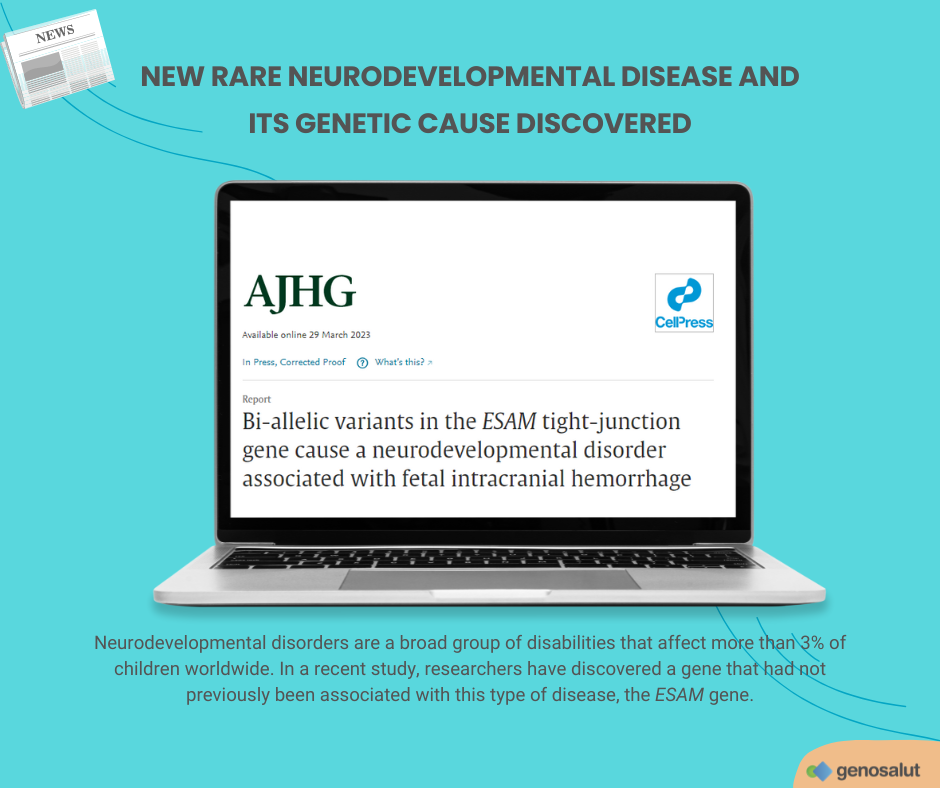Researchers from hospitals and research centres around the world have discovered a new rare neurodevelopmental disease. The disease is caused by a defect in the ESAM gene, which manifests as disruption of the blood-brain barrier. Affected individuals suffer from profound global developmental delay/unspecified intellectual disability, epilepsy, absent or severely delayed speech, varying degrees of spasticity, ventriculomegaly and intracranial haemorrhage/brain calcifications.

Neurodevelopmental disorders
Neurodevelopmental disorders (NDD) are a broad group of disabilities involving disorders of the brain and neurocognitive development that affect more than 3% of children worldwide. These disorders include one or more of the following characteristics: intellectual disability/developmental delay, autism, attention deficit hyperactivity disorder, epilepsy, cerebral palsy and language impairment.
Neurodevelopmental disorders are characterised by a failure to achieve cognitive, emotional and motor developmental milestones.
It is now estimated that more than 30% of these diseases have a genetic basis and, especially in recent decades, more than 1,500 genes associated with them have been identified.
The ESAM gene encodes a protein essential for the integrity of the blood-brain barrier
Recently, the article of a study in which two of the founding partners of Genosalut have participated has been published. This study has discovered a gene that had not previously been associated with rare diseases in humans, the ESAM gene.
It is a study carried out in thirteen individuals, including four foetuses, from eight unrelated families, in which hospitals and research centres from all over the world (Italy, USA, Israel, Spain, France, Switzerland, Turkey, Kuwait, United Kingdom, Canada) have participated.
Individuals were characterised by profound global developmental delay/unspecified intellectual disability, epilepsy, absent or severely delayed speech, varying degrees of spasticity, ventriculomegaly and intracranial haemorrhage/brain calcifications (the latter trait also observed in foetuses).
The ESAM (Endothelial Cell Adhesion Molecule) gene encodes a cell-cell attachment protein belonging to the immunoglobulin receptor family. This cell-cell junction is of vital importance in cells that form part of the blood-brain barrier, the central structure of the neurovascular unit (NVU), which plays a critical role in maintaining the homeostasis of the central nervous system.
The neurovascular unit (NVU) is a highly organised multicellular system located in the brain, consisting of neuronal, glial (astrocytes, oligodendrocytes and microglia) and vascular (endothelial cells and pericytes) cells. The blood-brain barrier is a component of the UNV.
The features observed by the authors of the paper in individuals with bi-allelic ESAM variants resemble those of other known conditions characterised by endothelial dysfunction due to mutation of genes encoding tight junctions molecules, namely the JAM2, JAM3 and OCLN genes. Because of the apparent importance of cell adhesion in the neurovascular unit, they propose to rename this group of diseases as “tightjunctionopathies“.
The identification of possible genetic causes of neurodevelopmental disorders is vital to understand the molecular mechanisms responsible for the onset of these disorders and to delineate a genotype-phenotype correlation that can help to monitor the evolution of the disorder and to anticipate future complications.
Exome and genome: key tools in determining the cause of neurodevelopmental disorders
This study re-emphasises the importance of the use of Next Generation Sequencing (NGS), Whole Exome Sequencing (WES) or Whole Genome Sequencing (WGS) technologies as the first diagnostic tests in neurodevelopmental disorders. Diagnostic success rates are currently around 30-40% and should ideally include parental analysis (exome-trio or genome-trio).
If you like our blog, subscribe to our newsletter


